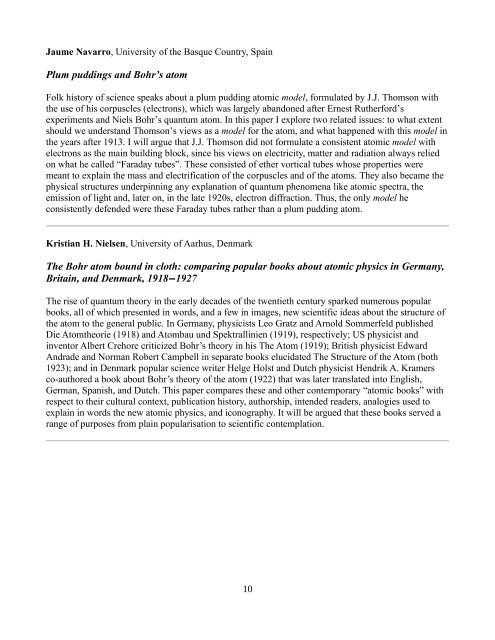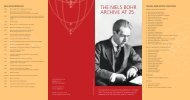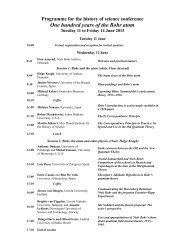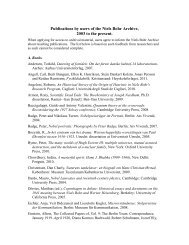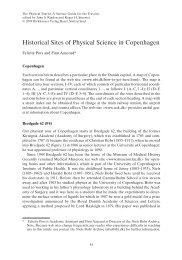Love and physics: Margrethe Nørlund and Niels Bohr's creativity ...
Love and physics: Margrethe Nørlund and Niels Bohr's creativity ...
Love and physics: Margrethe Nørlund and Niels Bohr's creativity ...
Create successful ePaper yourself
Turn your PDF publications into a flip-book with our unique Google optimized e-Paper software.
Jaume Navarro, University of the Basque Country, Spain<br />
Plum puddings <strong>and</strong> Bohr’s atom<br />
Folk history of science speaks about a plum pudding atomic model, formulated by J.J. Thomson with<br />
the use of his corpuscles (electrons), which was largely ab<strong>and</strong>oned after Ernest Rutherford’s<br />
experiments <strong>and</strong> <strong>Niels</strong> Bohr’s quantum atom. In this paper I explore two related issues: to what extent<br />
should we underst<strong>and</strong> Thomson’s views as a model for the atom, <strong>and</strong> what happened with this model in<br />
the years after 1913. I will argue that J.J. Thomson did not formulate a consistent atomic model with<br />
electrons as the main building block, since his views on electricity, matter <strong>and</strong> radiation always relied<br />
on what he called “Faraday tubes”. These consisted of ether vortical tubes whose properties were<br />
meant to explain the mass <strong>and</strong> electrification of the corpuscles <strong>and</strong> of the atoms. They also became the<br />
physical structures underpinning any explanation of quantum phenomena like atomic spectra, the<br />
emission of light <strong>and</strong>, later on, in the late 1920s, electron diffraction. Thus, the only model he<br />
consistently defended were these Faraday tubes rather than a plum pudding atom.<br />
Kristian H. <strong>Niels</strong>en, University of Aarhus, Denmark<br />
The Bohr atom bound in cloth: comparing popular books about atomic <strong>physics</strong> in Germany,<br />
Britain, <strong>and</strong> Denmark, 1918‒1927<br />
The rise of quantum theory in the early decades of the twentieth century sparked numerous popular<br />
books, all of which presented in words, <strong>and</strong> a few in images, new scientific ideas about the structure of<br />
the atom to the general public. In Germany, physicists Leo Gratz <strong>and</strong> Arnold Sommerfeld published<br />
Die Atomtheorie (1918) <strong>and</strong> Atombau und Spektrallinien (1919), respectively; US physicist <strong>and</strong><br />
inventor Albert Crehore criticized Bohr’s theory in his The Atom (1919); British physicist Edward<br />
Andrade <strong>and</strong> Norman Robert Campbell in separate books elucidated The Structure of the Atom (both<br />
1923); <strong>and</strong> in Denmark popular science writer Helge Holst <strong>and</strong> Dutch physicist Hendrik A. Kramers<br />
co-authored a book about Bohr’s theory of the atom (1922) that was later translated into English,<br />
German, Spanish, <strong>and</strong> Dutch. This paper compares these <strong>and</strong> other contemporary “atomic books” with<br />
respect to their cultural context, publication history, authorship, intended readers, analogies used to<br />
explain in words the new atomic <strong>physics</strong>, <strong>and</strong> iconography. It will be argued that these books served a<br />
range of purposes from plain popularisation to scientific contemplation.<br />
10


